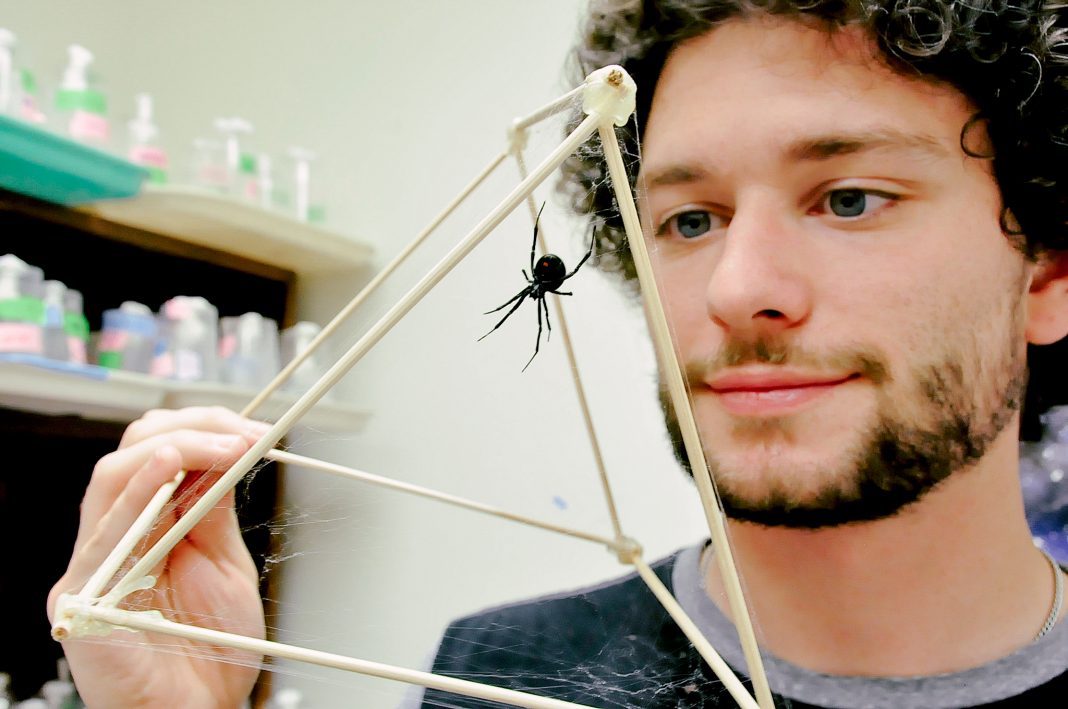Written by: Chris Baxter, SFU Student
SFU grad student Andreas Fischer keeps his lab stocked with around 100 specimens of Canada’s most poisonous spider, the black widow, as he works to find environmentally friendly solutions to pest control. These black widows have been collected from a variety of spots around B.C., including right here in the Lower Mainland.
One of Fischer’s goals as a researcher is to work towards debunking common misconceptions around spiders. Fischer has been working with spiders for four years, and he’s never been bitten.
“Not even a close call,” said Fischer in an interview with The Peak. To prove the spider’s harmlessness, he demonstrated with a short stick playing the part of a finger. “You see it? She walks away. I poke her, and she [makes] zero attempt to bite.”
Fischer works in SFU’s Gries Lab, which studies insects, spiders, and other animals often labelled as pests. The research done there aims to better understand how these animals communicate as well as how they might be controlled and contained in urban and agricultural settings using environmentally friendly methods.
“If we understand the language of the spiders properly, we can trap them or repel them and reduce the amount of pesticides,” explained Fischer.
In total, Fischer has collected approximately 600 spiders, including around 100 black widows, all of which need to be fed by hand once a week, a job that falls to an “army” of research assistants.
These spiders and the webs that they produce are the key to creating a green alternative for controlling spider populations. The spiders’ webs are collected and washed using a solvent to extract pheromones, similar to extracting tea flavours from tea leaves. The solvent is then analyzed with the goal of identifying and then synthesizing particular pheromones that attract other spiders. The spiders can sense these pheromones through hundreds of tiny hairs on their legs which they use to smell.
The idea is to use the pheromones to attract or repel other spiders. If successful, Fischer and his lab will be able to create traps for spiders that can replace the environmentally damaging use of pesticides and fumigation.
The studies associated with Fischer’s research are incomplete and yet to be published within the scientific community, but Fischer is optimistic that his research can lead to a greener future. He points to the recent fumigation of a government building in Ottawa, which was reported by CBC News, as an example of where his work could make a difference. Fischer suggests that the fumigation is “unnecessary because the spider is not dangerous, and it’s [. . .] toxic to spray those pesticides.” Traps using the spiders’ pheromones could potentially eliminate the need for poisons.
However, one limitation Fischer highlighted was that each pheromone would only work on one particular type of spider. The pheromones from a black widow, for example, would have no effect on other types of spiders, continued Fischer. Therefore, each trap could only be used to attract one type of spider. This could still be useful, however, in instances such as infestations where it would only be necessary to remove just one species of pest, explained Fischer.
Fischer demonstrated a clear enthusiasm for his research subjects, as he noted “[spiders] have such a bad reputation for nothing. There’s no good reason to be afraid of spiders.”
With advocates for our eight-legged cohabiter like Fischer, a wider understanding and appreciation of the spider is inevitable.
With files from CBC News and Nature Conservancy of Canada.




